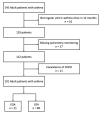Different Characteristics and Clinical Outcomes between Early-Onset and Late-Onset Asthma: A Prospective Cohort Study
- PMID: 36555926
- PMCID: PMC9785577
- DOI: 10.3390/jcm11247309
Different Characteristics and Clinical Outcomes between Early-Onset and Late-Onset Asthma: A Prospective Cohort Study
Abstract
Late-onset asthma (LOA) differs from early-onset asthma (EOA) in terms of prognosis and the treatment response because it has a much worse prognosis and a poorer response to standard asthma treatment. This study sought to investigate the characteristics and clinical outcomes of asthma patients with phenotypes distinguished by age at onset and atopy status. We prospectively recruited patients with asthma who were registered in a pay-for-performance program operated by Taiwan’s National Health Insurance Administration (NHIA). These patients received regular outpatient treatment for at least 1 year at every outpatient clinic visit since 2019. Baseline characteristics and clinical outcomes were compared between patients with LOA (≥40 years) and those with EOA (<40 years). Of the consecutive 101 patients with asthma, 21 patients (20.7%) had EOA and 80 (79.3%) had LOA. In the 12-month period, patients with EOA had higher declines in forced expiratory volume in one second (FEV1; −2.1 ± 8.4 vs. 6.8 ± 13.1, % of predicted value, p = 0.037) and forced vital capacity (FVC; −4.6 ± 12.0 vs. 6.1 ± 13.6, % of predicted value, p = 0.023) than patients with LOA. Patients with nonatopic EOA had a significantly higher exacerbation rate at 12 months than patients with nonatopic LOA (50% vs. 11.8%, p = 0.012). Identification of different phenotypes of asthma is important in clinical practice because treatment responses may differ.
Keywords: asthma; atopy; exacerbation.
Conflict of interest statement
The authors declare no conflict of interest. The funders had no role in the design of the study; in the collection, analyses, or interpretation of data; in the writing of the manuscript; or in the decision to publish the results.
Figures




References
-
- Moore W.C., Meyers D.A., Wenzel S.E., Teague W.G., Li H., Li X., D’Agostino R., Jr., Castro M., Curran-Everett D., Fitzpatrick A.M. Identification of asthma phenotypes using cluster analysis in the Severe Asthma Research Program. Am. J. Respir. Crit. Care Med. 2010;181:315–323. doi: 10.1164/rccm.200906-0896OC. - DOI - PMC - PubMed
Grants and funding
LinkOut - more resources
Full Text Sources

